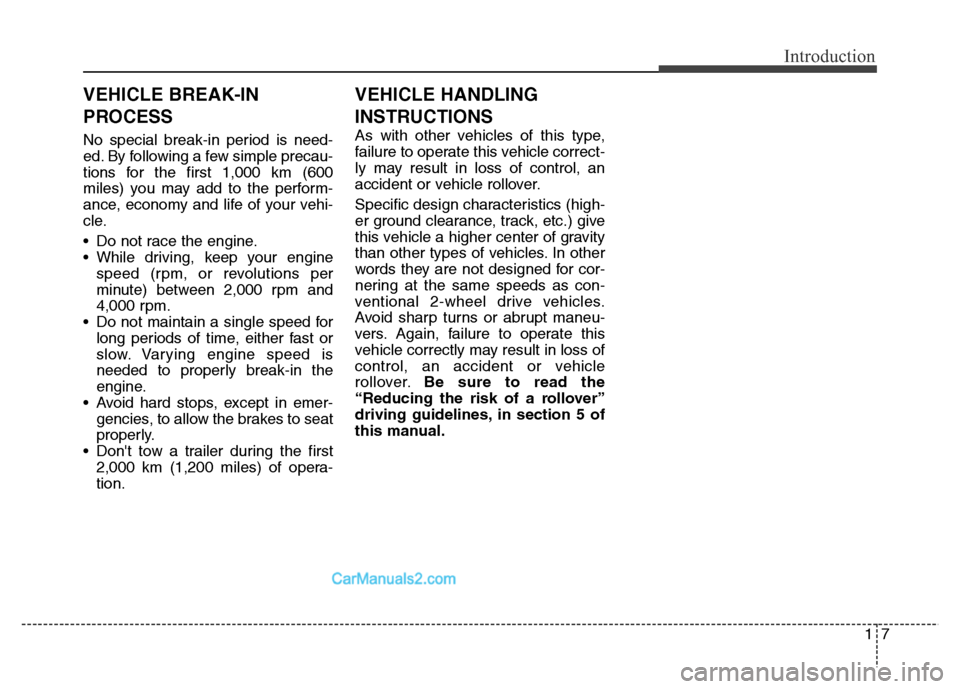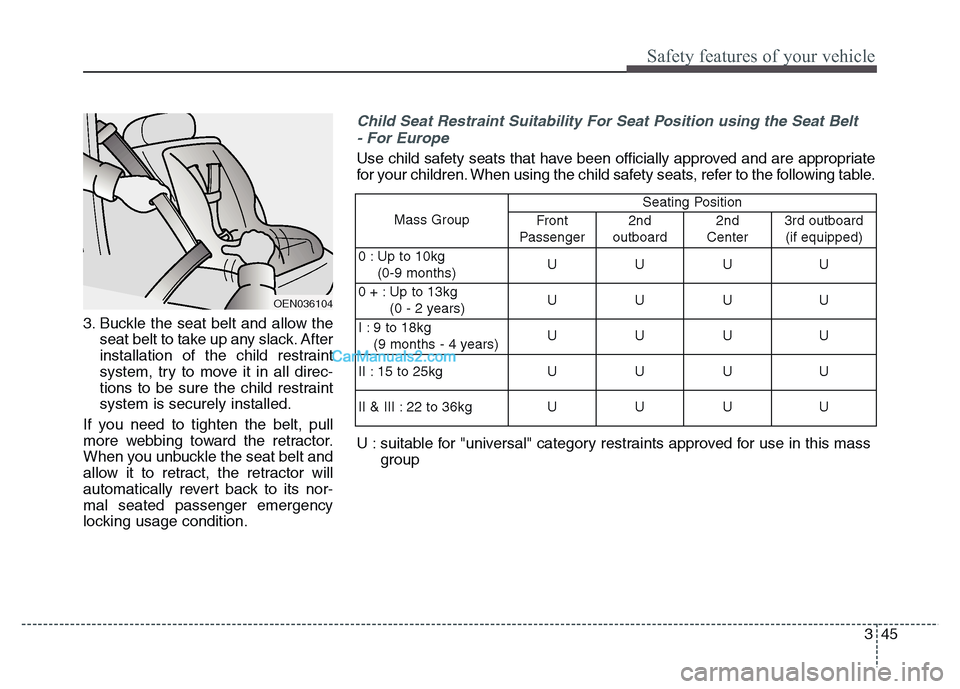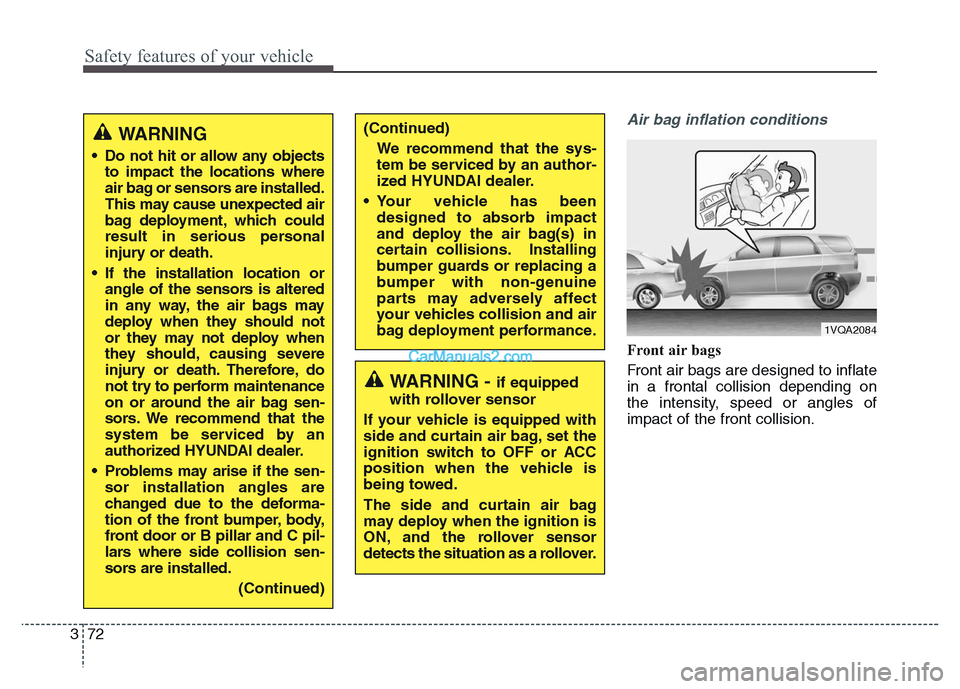Page 12 of 717

17
Introduction
No special break-in period is need-
ed. By following a few simple precau-
tions for the first 1,000 km (600
miles) you may add to the perform-
ance, economy and life of your vehi-
cle.
• Do not race the engine.
• While driving, keep your engine
speed (rpm, or revolutions per
minute) between 2,000 rpm and
4,000 rpm.
• Do not maintain a single speed for
long periods of time, either fast or
slow. Varying engine speed is
needed to properly break-in the
engine.
• Avoid hard stops, except in emer-
gencies, to allow the brakes to seat
properly.
• Don't tow a trailer during the first
2,000 km (1,200 miles) of opera-
tion.As with other vehicles of this type,
failure to operate this vehicle correct-
ly may result in loss of control, an
accident or vehicle rollover.
Specific design characteristics (high-
er ground clearance, track, etc.) give
this vehicle a higher center of gravity
than other types of vehicles. In other
words they are not designed for cor-
nering at the same speeds as con-
ventional 2-wheel drive vehicles.
Avoid sharp turns or abrupt maneu-
vers. Again, failure to operate this
vehicle correctly may result in loss of
control, an accident or vehicle
rollover.Be sure to read the
“Reducing the risk of a rollover”
driving guidelines, in section 5 of
this manual.
VEHICLE HANDLING
INSTRUCTIONS VEHICLE BREAK-IN
PROCESS
Page 15 of 717
23
Your vehicle at a glance
1. Antenna . . . . . . . . . . . . . . . . . . . . . . 4-194
2. Defroster. . . . . . . . . . . . . . . . . . . . . . 4-146
3. Parking assist system. . . . . . . . . . . . 4-108
4. Fuel filler lid . . . . . . . . . . . . . . . . . . . . 4-41
5. Towing hook . . . . . . . . . . . . . . . . . . . . 6-32
6. Rear combination lamp . . . . . . . . . . . 7-91
7. Rear window wiper blade . . . . . . . . . . 7-47
8. High mounted stop lamp . . . . . . . . . . 7-93
9. Rearview camera . . . . . . . . . . . . . . . 4-125
ONCEIN2002❈The actual shape may differ from the illustration.
■ Rear view
Page 31 of 717
Safety features of your vehicle
12 3
Adjusting the height up and down
To raise the headrest :
1. Pull it up to the desired position (1).
To lower the headrest :
1. Push and hold the release button
(2) on the headrest support.
2. Lower the headrest to the desired
position (3).To raise the headrest :
1. Pull it up to the desired position (1).
To lower the headrest :
1. Push and hold the release button
(2) on the headrest.
2. Lower the headrest to the desired
position (3).
ONCESA2016
■Type A
■Type B
ODMESA2220CN
OYFH034205
CAUTION
If you recline the seatback
towards the front with the head-
rest and seat cushion raised,
the headrest may come in con-
tact with the sunvisor or other
parts of the vehicle.
Page 39 of 717
Safety features of your vehicle
20 3
4.For 2nd row seat -
Pull on the seatback folding lever,
then fold the seat toward the front
of the vehicle. When you return the
seatback to its upright position,
always be sure it has locked into
position by pushing on the top of
the seatback.
For 3rd row seat -
Pull the strap. When you return the
seatback to its upright position,
always be sure it has locked into
position by pushing on the top of
the seatback.■2nd row seat
■3rd row seat
ODM032028/ONCDSA2100/ODM032030/ONCDSA2102
Page 41 of 717
Safety features of your vehicle
22 3
To fold down the rear center seat-
back (for 2nd row seat)
1. Lower the rear headrests to the
lowest position.
2. Push the center seatback folding
lever up, then fold the seat toward
the front of the vehicle.
When you return the seatback to its
upright position, always be sure it
has locked into position by pushing
on the top of the seatback.
WARNING - 2nd row cen-
ter seat folding
• Do not fold the 2nd row center
seat, if the occupants in the
3rd row seats, It may cause
the injury to occupants by the
seat device.
If occupants in the 3rd row
seats, Fix the upright position
of the 2nd row center seat.
(Continued)(Continued)
• The 2nd row center seat back
does not fix when it is folded.
If you use the 2nd row center
seat back folding function to
carry long objects, you should
fix the long object to prevent it
from being thrown about the
vehicle in a collision and
causing injury to vehicle
occupants.
ONCESA3117L
Page 52 of 717
333
Safety features of your vehicle
Stowing the rear seat belt
• The rear seat belt buckles can be
stowed in the pocket between the
rear seatback and cushion when
not in use.• Routing the seat belt webbing
through the rear seat belt guides
will help keep the belts from being
trapped behind or under the seats.
After inserting the seat belt, tighten
the belt webbing by pulling it up.
ODM032034
OXM039030
■2nd row seat
■3rd row seat (if equipped)
ODM032027
ODM032035
■2nd row seat
■3rd row seat (if equipped)
CAUTION
When using the seat belt, use it
after taking it out of the guides.
If you pull the seat belt when it
is stored in the guides, it may
damage the guides and/or belt
webbing.
Page 64 of 717

345
Safety features of your vehicle
3. Buckle the seat belt and allow the
seat belt to take up any slack. After
installation of the child restraint
system, try to move it in all direc-
tions to be sure the child restraint
system is securely installed.
If you need to tighten the belt, pull
more webbing toward the retractor.
When you unbuckle the seat belt and
allow it to retract, the retractor will
automatically revert back to its nor-
mal seated passenger emergency
locking usage condition.
OEN036104
Child Seat Restraint Suitability For Seat Position using the Seat Belt
- For Europe
Use child safety seats that have been officially approved and are appropriate
for your children. When using the child safety seats, refer to the following table.
U : suitable for "universal" category restraints approved for use in this mass
group
Mass GroupSeating Position
Front
Passenger2nd
outboard2nd
Center3rd outboard
(if equipped)
0 : Up to 10kg
(0-9 months)UUU U
0 + : Up to 13kg
(0 - 2 years)UUU U
I : 9 to 18kg
(9 months - 4 years)UUU U
II : 15 to 25kg U U U U
II & III : 22 to 36kg U U U U
Page 91 of 717

Safety features of your vehicle
72 3
Air bag inflation conditions
Front air bags
Front air bags are designed to inflate
in a frontal collision depending on
the intensity, speed or angles of
impact of the front collision.
WARNING - if equipped
with rollover sensor
If your vehicle is equipped with
side and curtain air bag, set the
ignition switch to OFF or ACC
position when the vehicle is
being towed.
The side and curtain air bag
may deploy when the ignition is
ON, and the rollover sensor
detects the situation as a rollover.
WARNING
• Do not hit or allow any objects
to impact the locations where
air bag or sensors are installed.
This may cause unexpected air
bag deployment, which could
result in serious personal
injury or death.
• If the installation location or
angle of the sensors is altered
in any way, the air bags may
deploy when they should not
or they may not deploy when
they should, causing severe
injury or death. Therefore, do
not try to perform maintenance
on or around the air bag sen-
sors. We recommend that the
system be serviced by an
authorized HYUNDAI dealer.
• Problems may arise if the sen-
sor installation angles are
changed due to the deforma-
tion of the front bumper, body,
front door or B pillar and C pil-
lars where side collision sen-
sors are installed.
(Continued)
(Continued)
We recommend that the sys-
tem be serviced by an author-
ized HYUNDAI dealer.
• Your vehicle has been
designed to absorb impact
and deploy the air bag(s) in
certain collisions. Installing
bumper guards or replacing a
bumper with non-genuine
parts may adversely affect
your vehicles collision and air
bag deployment performance.
1VQA2084